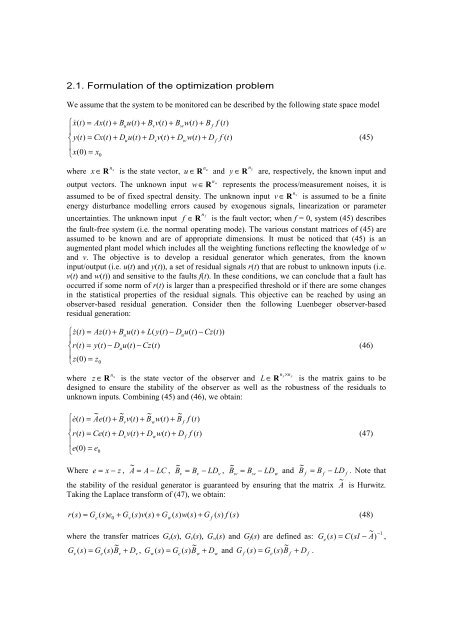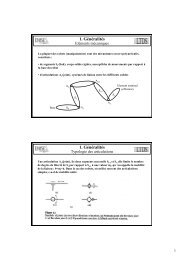q - Rosario Toscano - Free
q - Rosario Toscano - Free
q - Rosario Toscano - Free
You also want an ePaper? Increase the reach of your titles
YUMPU automatically turns print PDFs into web optimized ePapers that Google loves.
2.1. Formulation of the optimization problem<br />
We assume that the system to be monitored can be described by the following state space model<br />
⎧x&<br />
( t)<br />
= Ax(<br />
t)<br />
+ Buu(<br />
t)<br />
+ Bvv(<br />
t)<br />
+ Bww(<br />
t)<br />
+ B f f ( t)<br />
⎪<br />
⎨y(<br />
t)<br />
= Cx(<br />
t)<br />
+ Duu(<br />
t)<br />
+ Dvv(<br />
t)<br />
+ Dww(<br />
t)<br />
+ D f f ( t)<br />
⎪<br />
⎩x(<br />
0)<br />
= x0<br />
where<br />
x n<br />
u<br />
x ∈ R is the state vector, u ∈ R and<br />
n<br />
nw<br />
n<br />
y R<br />
(45)<br />
y<br />
∈ are, respectively, the known input and<br />
output vectors. The unknown input w ∈ R represents the process/measurement noises, it is<br />
nv<br />
assumed to be of fixed spectral density. The unknown input v ∈ R is assumed to be a finite<br />
energy disturbance modelling errors caused by exogenous signals, linearization or parameter<br />
n<br />
f<br />
uncertainties. The unknown input f ∈ R is the fault vector; when f = 0, system (45) describes<br />
the fault-free system (i.e. the normal operating mode). The various constant matrices of (45) are<br />
assumed to be known and are of appropriate dimensions. It must be noticed that (45) is an<br />
augmented plant model which includes all the weighting functions reflecting the knowledge of w<br />
and v. The objective is to develop a residual generator which generates, from the known<br />
input/output (i.e. u(t) and y(t)), a set of residual signals r(t) that are robust to unknown inputs (i.e.<br />
v(t) and w(t)) and sensitive to the faults f(t). In these conditions, we can conclude that a fault has<br />
occurred if some norm of r(t) is larger than a prespecified threshold or if there are some changes<br />
in the statistical properties of the residual signals. This objective can be reached by using an<br />
observer-based residual generation. Consider then the following Luenbeger observer-based<br />
residual generation:<br />
⎧z&<br />
( t)<br />
= Az(<br />
t)<br />
+ Buu(<br />
t)<br />
+ L(<br />
y(<br />
t)<br />
− Duu(<br />
t)<br />
− Cz(<br />
t))<br />
⎪<br />
⎨r(<br />
t)<br />
= y(<br />
t)<br />
− Duu(<br />
t)<br />
− Cz(<br />
t)<br />
⎪<br />
⎩z(<br />
0)<br />
= z0<br />
n<br />
x<br />
y<br />
where z ∈ R is the state vector of the observer and L ∈ R is the matrix gains to be<br />
designed to ensure the stability of the observer as well as the robustness of the residuals to<br />
unknown inputs. Combining (45) and (46), we obtain:<br />
~ ~ ~ ~<br />
⎧e&<br />
( t)<br />
= Ae(<br />
t)<br />
+ Bvv(<br />
t)<br />
+ Bww(<br />
t)<br />
+ B f f ( t)<br />
⎪<br />
⎨r(<br />
t)<br />
= Ce(<br />
t)<br />
+ Dvv(<br />
t)<br />
+ Dww(<br />
t)<br />
+ D f f ( t)<br />
⎪<br />
⎩e(<br />
0)<br />
= e0<br />
~<br />
~<br />
~<br />
~<br />
Where e = x − z , A = A − LC , Bv = Bv<br />
− LDv<br />
, Bw = Bw<br />
− LDw<br />
and B f = B f − LD f . Note that<br />
the stability of the residual generator is guaranteed by ensuring that the matrix A ~ is Hurwitz.<br />
Taking the Laplace transform of (47), we obtain:<br />
r e<br />
v<br />
w<br />
f<br />
( s)<br />
= G ( s)<br />
e0<br />
+ G ( s)<br />
v(<br />
s)<br />
+ G ( s)<br />
w(<br />
s)<br />
+ G ( s)<br />
f ( s)<br />
(48)<br />
nx<br />
× n<br />
where the transfer matrices Ge(s), Gv(s), Gw(s) and Gf(s) are defined as:<br />
~<br />
~<br />
~<br />
G v ( s)<br />
= Ge<br />
( s)<br />
Bv<br />
+ Dv<br />
, G w(<br />
s)<br />
= Ge<br />
( s)<br />
Bw<br />
+ Dw<br />
and G f ( s)<br />
= Ge<br />
( s)<br />
B f + D f .<br />
G e<br />
(46)<br />
(47)<br />
~<br />
( s)<br />
= C(<br />
sI − A)<br />
−1<br />
,



